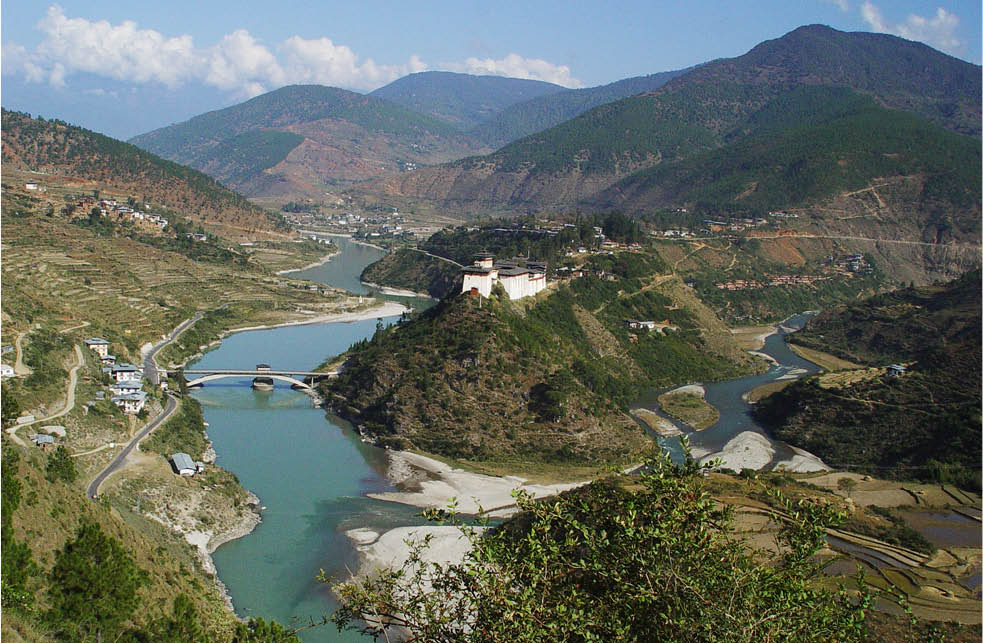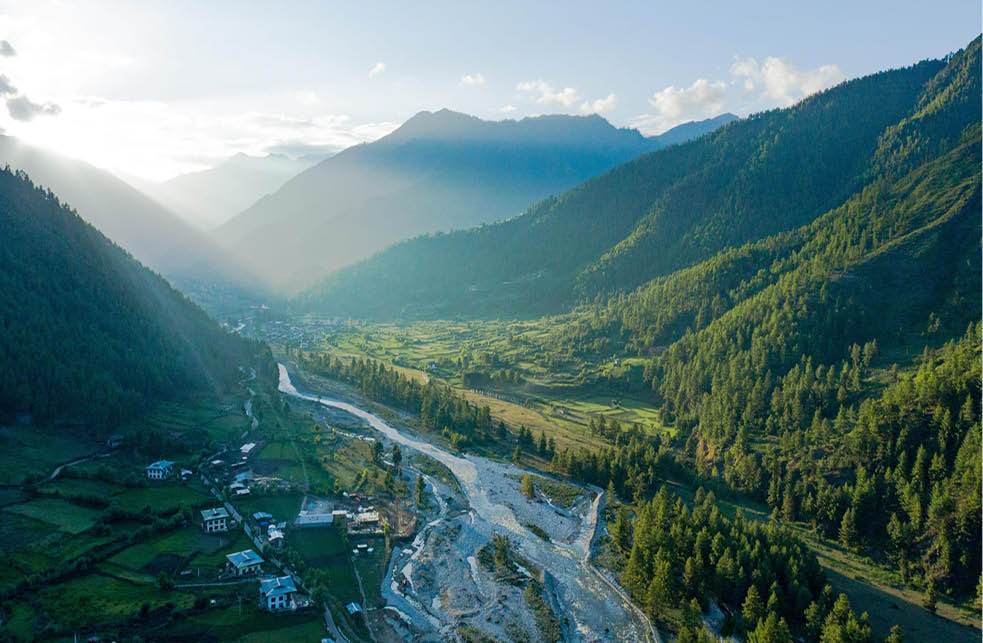


BHUTAN RAFTING TOUR
The two days spent rafting the magnificent Class II and IV rapids on the Po Chu and Mo Chu rivers, east of Punakha, are the highlight of this Bhutan Rafting Tour. Although rafting is a novel idea in Bhutan, its untamed rivers guarantee that it might offer some of the world’s greatest white water river rafting. The rafting route’s breathtaking flora and fauna serve as an uplifting backdrop to this amazing experience. Along with exploring the main attractions of Bhutan’s culturally diverse western valleys—Pookha, Punakha, and Thimphu—this trip offers stops at historic forts, temples, monasteries, farm cottages, and friendly people.
DAY 01: (Arrive Paro – Thimphu)
The flight to Paro is one of the most spectacular mountain flights in the world, with a constantly changing panorama of some of the highest mountains on earth. Our representative will meet you at Paro airport exit doors following customs formalities.
After lunch enjoy afternoon sightseeing around Paro, including a visit to the Ta Dzong Museum housing many religious relics, works of art and handicrafts offering a great orientation into Bhutan’s historical, cultural, and religious past. Next, visit the Rimpong Dzong to see the painting of the great saint Milarepa, considered as the master of meditation by the Bhutanese and believed to have attained enlightenment in a lifetime. Dzong’s are large monasteries and district administrative centres, which were once strategic forts. Afterwards, drive to the capital, Thimphu (1.5 hours) following the Pachu River. Before dinner at the hotel there will be an orientation on Bhutanese etiquette by your guide. Overnight at your hotel in Thimphu.
DAY 02: (Thimphu)
Once a rustic village sitting in a broad, fertile river valley, Thimphu is today the nation’s bustling capital. Enjoy a full day of sightseeing, including a visit to the National Memorial Chorten, completed by the Royal Queen Mother as a memorial stupa for the Third King who passed away in 1972. Continue on to 12th century Changangkha Temple and the Zilukha Nunnery. If your visit to Thimphu coincides with the weekend, you can walk through the Thimphu Market (Open only from Friday until mid Sunday). Overnight at your hotel in Thimphu.
DAY 03: (Thimphu)
Continue sightseeing in Thimphu. Visit the School for Arts and Crafts, The National Library housing the collection of Bhutanese scriptures dating back to the 8th century, the Traditional Paper Factory and a fascinating replica of a medieval farmhouse at the Folk Heritage Museum.
If there is time, you may visit the nursing pen for the Takin, the national animal of Bhutan, and Tashichhodzong, ‘the fortress of the glorious religion’ housing some ministries, His Majesty’s secretariat, and the central monk body. Other options for the day include a hike to Tango and Cheri Monasteries (45 mins), two of the most ancient monasteries in the Thimphu region or a hike to Phajoding Monastery providing a splendid view of the valley. Overnight at your hotel in Thimphu.
DAY 04: (Thimphu – Punakha)
Drive over the Dochu-La pass (3,100 meters), which on a clear day offers an incredible view of Himalayan peaks before descending into balmy Punakha valley (about 3 hrs total driving time). The drive through the countryside affords a glimpse of everyday life in this most remote of Himalayan kingdoms. In the Dochu-La area there are vast Rhododendron forests that grow to tree size and bloom in late April/early May covering the mountains in a riot of glorious spring colour.
Punakha was the ancient capital of Bhutan. On arrival, visit Punakha Dzong, the “Palace of Great Happiness” built in 1637 by the Shabdrung, the ‘Unifier of Bhutan’. It is the winter headquarters of the Je Khenpo and hundreds of monks who move en masse from Thimphu to this warmer location. The three story main temple of the Punakha Dzong is a breathtaking example of traditional architecture with four intricately embossed entrance pillars crafted from cypress and decorated in gold and silver. It was here in 1907 that Bhutan’s first king was crowned.
After lunch, enjoy a walk to Chimi Lhakhang, temple of Drukpa Kuenly. He inherited the Divine Madman title since he revolted against the orthodox Buddhism in his time. He taught the people that religion is an inner feeling and it’s not necessary that one should be an ordained monk. He is also considered a symbol of fertility. Overnight at your hotel in Punakha/ Wangduephodrang.
DAY 05: (Punakha (Rafting))
After breakfast, hike through pine forest and farming fields along the bank of Pho Chu River for about 2 hours until you reach Samdhingkha, where your rafting crew will be waiting. After a debriefing, you will start rafting along the rocky Pho Chu River coming across exhilarating stretches of Class II and IV rapids. Accompanying this fine stretch of river are beautiful landscapes of farmlands, hills dotted with monasteries, and forest areas full of birdlife. Enjoy lunch on a sandy embankment close to a Chorten. The post-lunch rafting session will continue until you reach the relatively placid section of the river below the imposing Punakha Dzong. Overnight at your hotel in Punakha/ Wangduephodrang.
DAY 06: (Punakha (Rafting))
After breakfast drive to your departure point for rafting the Mo Chu River. This section takes four hours and has some class II rapids. As well as superb rafting conditions, this river also affords beautiful views and an insight into Bhutanese daily life. After lunch in Punakha, enjoy a walk to Chimi Lhakhang, temple of Drukpa Kuenly who is also known as the Divine Madman. He inherited the Divine madman title since he revolted against the orthodox Buddhism of his time. He is considered a symbol of fertility and many childless couples go to his temple for blessing. Overnight at your hotel in Punakha/ Wangduephodrang.
DAY 07: (Punakha – Phobjikha Valley)
Transfer to Phobjikha Valley (3 hrs) via the bustling market town of Wangduephodrang. Drive up a winding mountain road through oak and rhododendron forests, and over a high pass down into the picturesque Phobjikha Valley. Phobjikha is one of Bhutan’s few glacial valleys, and chosen winter home of black necked cranes (November – March) migrating from the Tibetan plateau. After lunch visit the Phobjikha Sanctuary to view the majestic black necked cranes (Nov-Mar only) and Gangtey Gompa (Monastery), dating back to the 16th century. Overnight at your hotel in Phobjikha.
DAY 08: (Phobjikha valley – Paro)
After breakfast, commence the drive back to Paro. Enjoy a picnic lunch at one of the numerous picturesque locations along this route. On arrival in Paro you may enjoy a visit to the downtown area, or simply spend some time relaxing at your hotel. Overnight at your hotel in Paro.
DAY 09: (Paro)
After breakfast hike to Taktsang Monastery. The walk of approximately 1.5 to 2 hours uphill takes you almost a kilometre above the Paro valley floor (for those who cannot hike we will arrange a horse for transfer up to cafeteria). The view of Taktsang Monastery built on a sheer cliff face 900 metres above the valley floor is a spectacular sight. The Monastery is also an important pilgrim site for the Buddhists. The great Guru Rimpoche is said to have flown here on the back of a tigress when he brought the teachings of the Buddhist Dharma to Bhutan in the 8th Century. Nearby there is a teahouse where you can stop for refreshments before returning to Paro for lunch.
In the afternoon drive to the almost fully reconstructed Drukgyel Dzong. The original monument (destroyed by fire in 1951) was built by Shabdrung to commemorate his victory against invading Tibetans in 1644. In fine weather the towering peak of the sacred Mount Jomolhari (7314m) appears as a stunning backdrop. On the return drive to Paro, visit other sights in Paro valley. Overnight at your hotel in Paro.
DAY 10: (Depart Paro)
Breakfast in the hotel, then drive to the airport for flight to your onward destination.
Tashi Delek!




